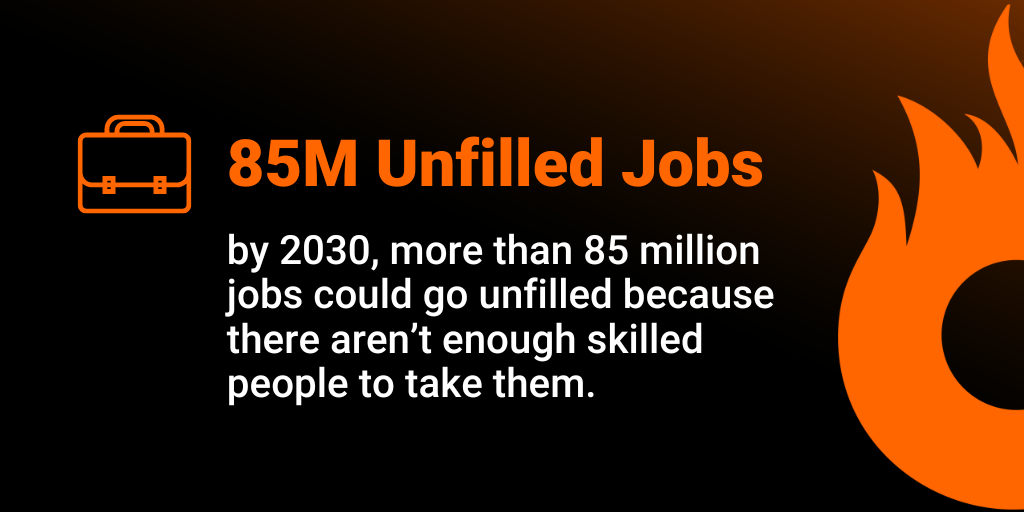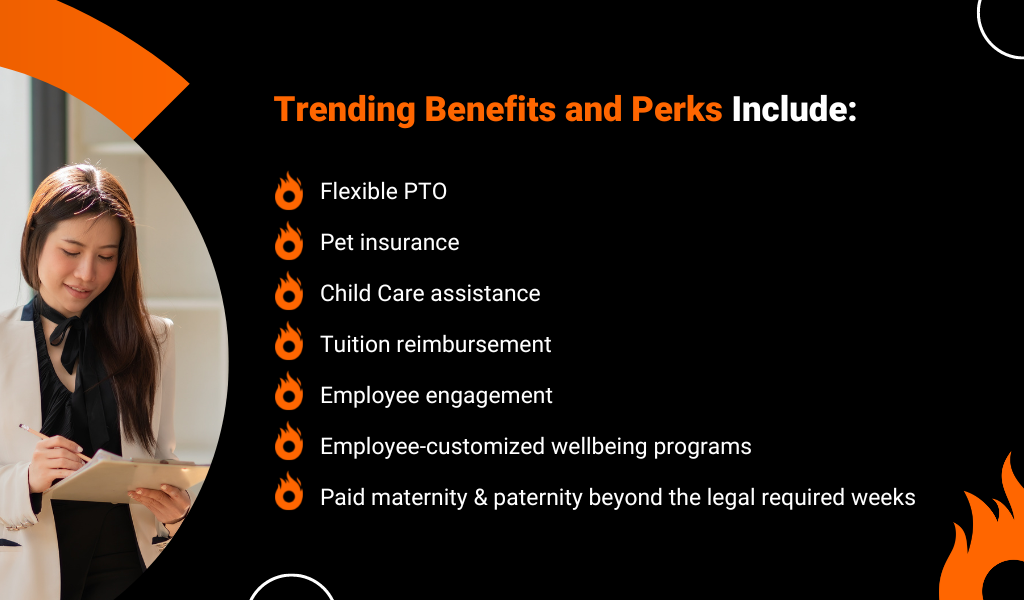The race to attract top talent is hot, and shows no signs of slowing. Only now, it’s not just about recovering from an unexpected change in the market. Experts of identified a legitimate labor shortage. If you’re left wondering, “What am I supposed to do now?”- you’re not alone.
Recruiters across the nation are still navigating a tumultuous market with 11 million job openings and only about half as many unemployed. The labor changes in the US aren’t entirely unique; similar scenarios are also taking place in the UK and Australia. Obviously, the pandemic threw a wrench into the labor force, but what else is going on?
For one, the talent pipeline has always been somewhat limited for many reasons, including geography, diversity, and skillset. With an increased demand for labor and a decrease in labor availability, this talent shortage is only amplified. Many companies have been trying to mitigate this through upskilling their current workforce or by partnering with education institutions but there’s only so much that can be done when there simply aren’t enough people to fill the roles.
This leaves employers in quite the predicament because they need labor to keep their businesses running but there aren’t enough people available. So what now? Well, it depends on the business needs and industry but it may be necessary to get creative with sourcing strategies, compensation packages, or work location/hours. The key is to stay ahead of the curve and anticipate your labor needs so that you can be proactive instead of reactive when it comes to attracting top talent.
[bctt tweet=”A pandemic, the slow recovery, and now a labor shortage. Top recruiter pain point right now is the lack of candidates. Here’s how we get through it:” via=”no”]
Talent Shortage: Where Are the Qualified Candidates?!
An extensive new Korn Ferry report finds that by 2030, more than 85 million jobs could go unfilled because there aren’t enough skilled people to take them. Not only does it make it difficult for TA teams to fill positions, but it also makes retaining employees difficult. The talent shortage was brought on by a few dynamics at play:
Older Generations Are Retiring
Baby Boomers — people born between 1946 and 1964 — make up about one-third of the workforce, and a good majority of them are now retiring or plan to retire in the near future. The COVID-19 Pandemic seemed to accelerate the rate at which they left the workforce. In the third quarter of 2020 alone, nearly 30 million Baby Boomers were forced into retirement, leaving an unexpected gap in talent no one saw coming. With them, they took years of knowledge that couldn’t be recovered quickly. Why?
The labor shortage caused by the retirement of Baby Boomers is expected to have a ripple effect on the economy. As more and more businesses struggle to find qualified workers, they will be forced to raise prices or cut back on services. This, in turn, will lead to inflation and slower economic growth. In addition, the labor shortage could exacerbate existing problems, such as the shortage of affordable housing.
As baby boomers leave the workforce, there will be fewer people to fill the jobs that support the housing market, making it even harder for young people to afford a place to live. The labor shortage caused by the retirement of baby boomers is a problem that is likely to have far-reaching consequences.
Younger Generations Are Ill-Equipped to Fill Roles Left Behind
As the labor shortage continues to bite, more and more businesses are turning to millennials to fill the skills gap. However, while millennials may be the largest generation in the labor force, they simply can’t make up for the experience gap left behind by employees thirty-plus years their senior. This means that businesses need to find ways to attract and retain top millennial talent.
One way of doing this is by offering roles that play to the strengths of this generation. For example, millennials are often very comfortable with technology, so roles that require them to use technical skills are likely to appeal. They’re also used to working in fast-paced environments, so businesses that can offer this type of environment are more likely to attract top talent. Ultimately, attracting and retaining millennial talent is a challenge for businesses, but one that’s well worth taking on.
Nearly Everything Has Changed
The workforce is in the midst of a rapid transformation. Technology is advancing, the expectations of employees are quickly evolving, and employers are rushing to meet them. We saw the sudden rush of remote work take over the workplace during the pandemic. The use of technology quickly adapted to meet the need, which meant an influx in necessary skills and experiences to accommodate.
Worker expectations are leading to higher wages, more flexibility, better work-life balance, and remote-work options. As such, employers are adjusting expectations for what success in their organization looks like, and these changing expectations only continue to evolve as we all settle into “the new normal.”
In this rapidly changing landscape, internal mobility has become an essential tool for organizations to promote career growth and development for their employees. By providing opportunities for employees to move within the company, organizations can help them gain the skills and experiences they need to be successful in this ever-changing world.
[bctt tweet=”Attract the top talent you need– yes, even during a talent shortage. @MojoHire has the details:” via=”no”]
What Can Organizations Do to Attract Talent?
So how do recruiters and HR teams attract top talent they need to keep industries and organizations running smoothly?
Rethink your talent pool.
If you’re looking to attract top talent, you need to think outside the box. How can you identify potential stars among the masses? By rethinking your talent pool, turning up your talent discovery strategy, and building a positive candidate experience. Let’s dive deeper into each of these important methods.
When it comes to finding top talent, it’s important to think outside the box. How can you identify potential stars among the masses? By rethinking your talent pool, turning up your talent discovery strategy, and building a positive candidate experience. Let’s dive deeper into each of these important methods.
Rethinking your talent pool means revisiting previous applicants and runner-up candidates and selecting technology that allows your recruiters to do this with ease. Revisit candidates who have previously expressed interest in your company. Reaching out to candidates who have a history with your organization gives the impression that they’ve stayed on your radar and builds up a positive candidate experience from the start.
Turning up your talent discovery strategy also means taking a closer look at how you source your candidates. Where are you looking for candidates? Are you using all available resources? There are many methods to attract top talent, so make sure you’re using a variety of methods.
Building a positive candidate experience is essential for attracting top talent. Candidates should feel valued throughout the entire process, from initial contact to post-interview follow-up. If a candidate feels like just another number, they’re likely to take their talents elsewhere.
Overhaul your offering.
Traditional benefits of health insurance and 401(k) won’t cut it with the labor shortage in full swing. Employers will need to go bigger and find out what perks employees really want.
Internal talent marketplace. Overlooking the talent under your own roof is a rookie mistake. Building up your own internal mobility is the best way to secure talent for your organization’s future.
By investing in training, job shadowing, and continued education, you effectively prepare your company’s talent to take over higher-level positions as they become available. Bonus: It encourages talent retention as you create opportunities for their career advancement.
Embrace hybrid work.
You’ve seen the polls, you’ve heard the rumblings. Remote work isn’t going away anytime soon. So if you’re in a position to do so, consider creating a hybrid work environment to attract top talent. Employees today are insisting on a better work-life balance. And as more companies discover their productivity doesn’t suffer in offering such a benefit, it’s becoming more common.
This also helps expand your target hire, since you don’t have to rely on your idea candidate living within a 15 mile radius of your office. Remote and flexible work schedules help attract the best candidates and gives you a larger pond to fish in.
Level up your TA tech. Artificial intelligence is the recruiter’s secret weapon, so when the technology falls short, you could be causing more pain points than you’re solving. HRM systems like Workday, Oracle, and SAP success factors aren’t built for recruiting. The Applicant Tracking Systems and other recruiting features were set up as afterthoughts to the HRM features, so your recruiting team is left to fill in the gaps manually via excel spread sheets, managing communications via email, etc.
Enter MojoHire, a sleek, intuitive overlay that turns your clunky, disparate systems into a streamlined talent acquisition powerhouse. From candidates trapped in black holes to an always-refreshed talent pipeline, from wrestling with hiring bias to nail your DEI initiatives, from trying to locate lost requisitions and create skill maps to seeing at-a-glance where the gaps and fonts of skills lie in your organization (and leveraging them to build career pathways for your employees.)
MojoHire has solved the riddle that’s been plaguing TA for the last decade. And not a minute too soon. Before overhauling your entire talent acquisition strategy to attract top talent, ensure your HRM is working for you instead of against you. Schedule a demo with MojoHire today.








